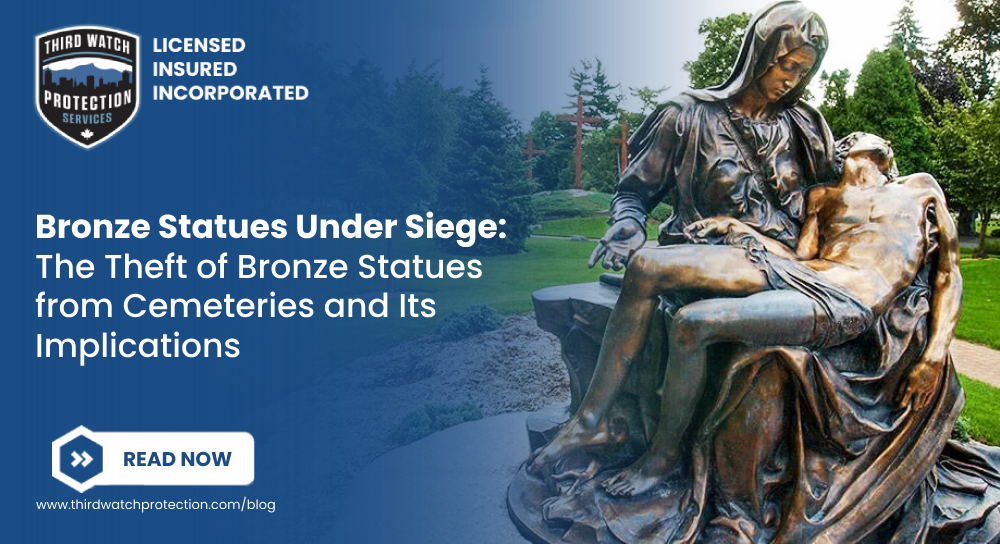Bronze Statues Under Siege: The Theft of Bronze Statues from Cemeteries and Its
Implications
In recent years, Ontario has witnessed a disturbing trend: an increase in thefts targeting the serene spaces of cemeteries and mausoleums. The theft of bronze statues, which represents not only a financial loss but also an emotional blow to families and communities, raises critical questions about our society and the respect we afford to the deceased and their resting places. This phenomenon reflects deeper issues that warrant analysis and discussion.
The Growing Problem of Cemetery Looting
Cemeteries are meant to be peaceful sanctuaries, places where we honor our loved ones and reflect on the lives they’ve led. Sadly, these sacred grounds have become targets for thieves seeking to profit from the high market value of bronze. Over the past few years, reports have emerged from various municipalities across Ontario, detailing numerous incidents of theft involving these cherished memorials. Statues, plaques, and decorative motifs made of bronze are being stolen at an alarming rate, often in plain view.
In many cases, the statues are not only thefts of material items but also violent disruptions of the peace and respect that these locations demand. They carry significant aesthetic, historical, and sentimental value, marking the final resting places of individuals and reflecting the artistry and craftsmanship of a bygone era. When these items are ripped from their settings, it not only robs the physical monument but also damages the shared memory and mourning space of communities.
The Motive Behind the Madness
The primary motivation behind these thefts is financial gain. The increase in bronze prices, driven by various economic factors including manufacturing demands, mining conditions, and global commodity prices, has made bronze an attractive target for criminals. Thieves can haul away these hefty pieces and sell them to scrap metal dealers for a substantial profit.
The rise of online marketplaces has further complicated this issue. Platforms like Kijiji and Facebook Marketplace make it easy for criminals to offload stolen goods without immediate identification. With a few clicks, they can turn cherished monuments into cash, all while remaining hidden behind the anonymity of the internet.
The Emotional Toll
The impact of these thefts is far-reaching, affecting not only the families who have lost their memorials but also the broader community. The emotional toll is profound; for many, the statue represents not just a memory but a connection to their loved one. The theft of such statues can leave families feeling violated and grieving anew.
Moreover, such acts of vandalism disrupt the community’s collective mourning process. Cemeteries are sacred spaces, and when they are disrespected in this way, it creates a ripple effect of loss and sorrow. Local communities often come together to care for these communal spaces, and seeing them plundered can lead to feelings of helplessness and anger.
Community Response and Prevention
In light of this troubling trend, various communities across Ontario are rallying together to take action. Several cemeteries have implemented increased security measures, such as surveillance cameras and improved lighting. Local authorities are also partnering with law enforcement agencies to establish patrols in areas known for cemetery theft.
In some cases, communities have banded together to raise awareness about the importance of protecting these spaces. Educational campaigns aim to inform the public about the significance of these monuments and the ramifications of theft—not just in monetary terms, but also regarding community identity and shared values.
Moreover, families are increasingly encouraged to report any thefts to the police and to their local cemetery management. By creating a more vigilant community, it becomes harder for thieves to operate without being noticed.
Legal and Ethical Implications
The legal framework surrounding the theft of cemetery property is multi-faceted and complicated. While theft is undoubtedly a crime, the question of how law enforcement deals with it often varies based on the jurisdiction and the resources available.
In response to the rising crime rates, some municipalities have begun pushing for stricter regulations related to scrap metal purchases. Many argue that scrap dealers should be required to provide proof of ownership and identification when purchasing metal. By closing the loopholes that enable these thefts, it becomes more challenging for thieves to profit from their crimes.
Moreover, discussions around the ethical considerations of how we honor the dead and preserve their memories have emerged. Some stakeholders argue that a communal effort to create more meaningful memorials or interactive spaces could shift the focus away from material objects toward richer, collective experiences.
Preserving Ontario’s History
Bronze statues in cemeteries and mausoleums are not merely decorative; they often signify a significant aspect of Ontario’s social and cultural history. Many were crafted by talented artisans, embodying techniques and styles from various historical periods. The loss of these sculptures amounts to losing a fragment of cultural heritage that can never be restored.
Efforts to document and catalog existing monuments can serve as a means of preservation. Local historical societies and groups can work together to maintain an inventory of sculptures, plaques, and memorials, ensuring that communities remain aware of their cultural treasures.
In Conclusion
The theft of bronze statues from cemeteries and mausoleums in Ontario is a troubling indicator of how far some individuals will go for financial gain, regardless of the emotional and cultural costs involved. This trend calls for a collective response from law enforcement, municipal governments, community organizations, and residents.
As a society, we must reaffirm our commitment to honoring the dead and preserving the sanctity of their resting places. The actions we take today in response to this issue will likely shape the legacy we leave for future generations. It’s essential to advocate for preventative measures, support local initiatives, and raise awareness about the impact of these thefts.
Together, we can create a more respectful environment for all and ensure that our cemeteries continue to serve as sacred spaces for remembrance and reflection—a tangible connection to our history and our loved ones.
Why not consider hiring a patrol service to address your security needs? Patrol services offer excellent option for improving security at your property. If you’re interested in learning more, don’t hesitate to contact a reliable patrol service provider. If you’re in the market for a new security provider, Third Watch Protection Services would be happy to help protect your property. You can reach us by calling 1-888-444-5232 or emailing us at mail@thirdwatchprotection.com to get started today!



